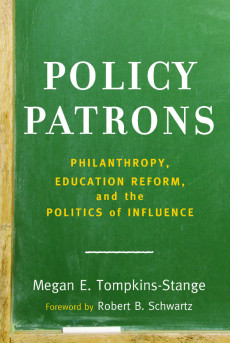
Policy Patrons: Philanthropy, Education Reform, and the Politics of Influence
Megan E. Tompkins-Stange
199 pages, Harvard Education Press, 2016
In Policy Patrons, Megan E. Tompkins-Stange, one of the most impressive scholars to emerge from the Stanford Center on Philanthropy and Civil Society program, has turned her doctoral dissertation into a brief, lively book on how mega-foundations go about trying to reform K-12 education in the United States. Her approach is essentially anthropological: She has interviewed 60 anonymous informants who work for four major private foundations that off er a sample of the mega-foundation universe: Gates, Broad, Kellogg, and Ford.
But this book is not really about education policy. It is about how big funders use their financial resources to push for the reforms they seek. The book asks whether the widespread acceptance of a strategic, outcome-oriented approach to funding education among foundations constitutes a worrisome intrusion into the democratic process. Should we be concerned that elite institutions almost totally lacking in democratic transparency have used their wealth to influence public policy in a domain as crucial as public education?
Tompkins-Stange is reluctant to make a judgment on this question, although she offers words of caution. She writes that “foundations would be wise to devote institutional attention to the consideration of age-old questions about their role in the public realm and to purposefully determine their policy strategies with these normative issues in mind.” And she warns that “in the absence of formal bureaucratic mechanisms that are designed to ensure greater foundation transparency and accountability, foundations are unlikely to incorporate strategies that reflect these norms.”
This seems too timid. As Tompkins- Stange makes clear, these funders have influenced federal and state policymakers to adopt many elements of their reform agenda. They have vigorously pushed for charter schools and high-stakes testing, and opposed teachers’ unions, positions that the US Department of Education has accepted in various programs. At the same time, these foundations consistently deny that their “small” amounts of funding could influence the direction of federal education policy, given the huge sums that the government itself spends.
But most government money goes to operating funds, while philanthropic money supports specific programs, allowing foundations to have disproportionate influence relative to their size. As one Ford Foundation official told Tompkins-Stange, the scale of funding is not as important as “targeting and focusing on concentration.” The burgeoning number of charter schools, many authorized specifically by foundation-supported state and local initiatives, shows what private money can do to alter the contours of public education. That outsized influence is the hallmark of strategic philanthropy.
Tompkins-Stange acknowledges the centrality of foundations’ strategy as well as size in her decision to group the four she examines in pairs that share basic grantmaking outlooks (Ford-Kellogg and Broad-Gates). Ford and Kellogg, she contends, tend to offer general operating grants and devolve control away from foundation staff and toward reasonably self-directed grantees. Broad and Gates, on the other hand, work with expert and elite groups to enact the programs that they have determined to be most effective. The first pair tends to be “adaptive,” the second “technical.” The first is “field-oriented,” the second “outcome-oriented.”
Tompkins-Stange is very sensible in her use of these generalizations, pointing out that none of the four foundations operates totally within its category. But although she never says so directly, she seems more sympathetic to the Ford-Kellogg approach, since it is more genuinely responsive to the preferences of those affected by philanthropic policies. Overall, however, she correctly notes that all four foundations operate within the growing field of “strategic” philanthropy: They are “interested in accomplishing concrete outcomes that yield significant return on investment, often organized around initiatives that reflect market-based values.”
Of course, big foundations have always been interested in achieving impact, but they have not always been so focused on it, nor have they been so inclined to achieve it by making “big bets” on their strategies. It is no accident that so many of the new mega-philanthropists have enriched themselves in the hedge-fund business. Foundations have always been accused of arrogance, but this generation of funders carries arrogance to new levels, promoting policy objectives that in many cases clearly oppose local public opinion.
Tompkins-Stange’s reason for allowing informant anonymity in the book is clear: These staffers would not have talked to her otherwise. As someone who has been writing foundation history for 40 years, I can assure readers that it is nearly impossible to secure on-the-record interviews with philanthropoids. Some readers, however, will share my frustration at a volume composed almost entirely of unattributed quotations.
I admire this book, but now I would like to read another Tompkins-Stange book that explains why mega-foundations’ K-12 policies are a threat to democratic public education and suggests how to make elite institutions more accountable to the public. Tompkins-Stange sees that both the scale and the method of funding matter, and she hints that the public should be concerned about their convergence in mega-foundations. But she stops short of showing why this convergence is bad for public education in our democratic republic.

